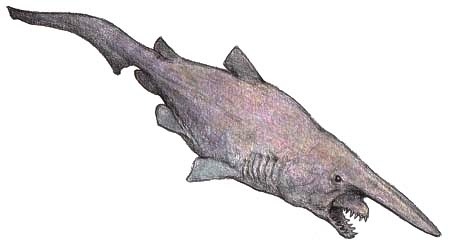the ideadex: a fakemon inspiration blog
RSS
The goblin Shark, Mitsukurina owstoni (1898)
Phylum : Chordata
Class : Chondrichthyes
Subclass : Elasmobranchii
Order : Lamniformes
Family : Mitsukurinidae
Genus : M. owstoniPhylogenetic studies based on morphology have generally placed the goblin shark as the most basal member of the order Lamniformes, known as mackerel sharks. Studies using genetic data have also supported a basal position for this species. The family Mitsukurinidae, represented by Mitsukurina, Scapanorhynchus, and Anomotodon, dates back to the Aptian age of the Cretaceous period. Mitsukurina itself first appears in the fossil record during the Middle Eocene extinct species include M. lineata and M. maslinensis.Striatolamia macrota, which lived in warm shallow waters during the Paleogene, may also be a Mitsukurina species. As the last member of an ancient lineage, and one that retains several “primitive” traits, the goblin shark has been described as a “living fossil”.
The goblin shark has a distinctively long and flattened snout, resembling a sword blade. The proportional length of the snout decreases with age. The eyes are small and do not have protective nictitating membranes; behind the eyes are spiracles. The large mouth is parabolic in shape. The jaws are highly protrusible and can be extended almost to the end of the snout, though normally they are held flush against the underside of the head. There are 35–53 upper and 31–62 lower tooth rows. The teeth in the main part of the jaws are long and narrow, particularly those near the symphysis (jaw midpoint), and are finely grooved lengthwise. The rear teeth near the corners of the jaw are small and have a flattened shape for crushing. There is much among-individual variation in tooth length and width, in whether the teeth have a smaller cusplet on each side of the main cusp, and in the presence of toothless gaps at the symphysis or between the main and rear teeth. The five pairs of gill slits are short, with the gill filaments inside partly exposed; the fifth pair is above the origin of the pectoral fins.
The body is fairly slender and flabby. The two dorsal fins are similar in size and shape, both being small and rounded. The pectoral fins are also rather small and rounded. The pelvic and anal fins have long bases and are larger than the dorsal fins. The caudal peduncle is flattened from side-to-side and lacks keels or notches. The asymmetric caudal fin has a long upper lobe with a shallow ventral notch near the tip, and an indistinct lower lobe. The soft, semi-translucent skin has a rough texture from a covering of dermal denticles, each shaped like a short upright spine with lengthwise ridges. In life, this species is pink or tan due to visible blood vessels beneath the skin; the color deepens with age, and young sharks may be almost white. The fins’ margins are translucent gray or blue, and the eyes are black with bluish streaks in the iris. After death, the coloration quickly fades to dull gray or brown.
 dvirpod liked this
dvirpod liked this  gregoyr liked this
gregoyr liked this saurianprophecies liked this
ben-the-hyena liked this
ayyyylmaooooooo reblogged this from palaeopedia
skull-kraken reblogged this from palaeopedia
 killerseventynine liked this
killerseventynine liked this lipid liked this
americanabyss liked this
fullmoonfright-fizzy liked this
mufinfriday liked this
anticharacter liked this
naturall--disaster reblogged this from palaeopedia
 siemens-ssk-iran-beijing-ai-blog reblogged this from palaeopedia
siemens-ssk-iran-beijing-ai-blog reblogged this from palaeopedia noahfromthesea reblogged this from palaeopedia
noahfromthesea liked this
forestfairyunicorn liked this
gojira007 liked this
jesters-armed liked this
frilled-shark reblogged this from shaaarks
 fenouil reblogged this from shaaarks
fenouil reblogged this from shaaarks  saguusa reblogged this from snoodlepip
saguusa reblogged this from snoodlepip snoodlepip reblogged this from palaeopedia
m00n-prince liked this
lyresnake liked this
bombastaway liked this
thepurplepsyduck liked this
ohplesiosaur reblogged this from palaeopedia
brian-my-left-testicle liked this
palaeopedia posted this
- Show more notes